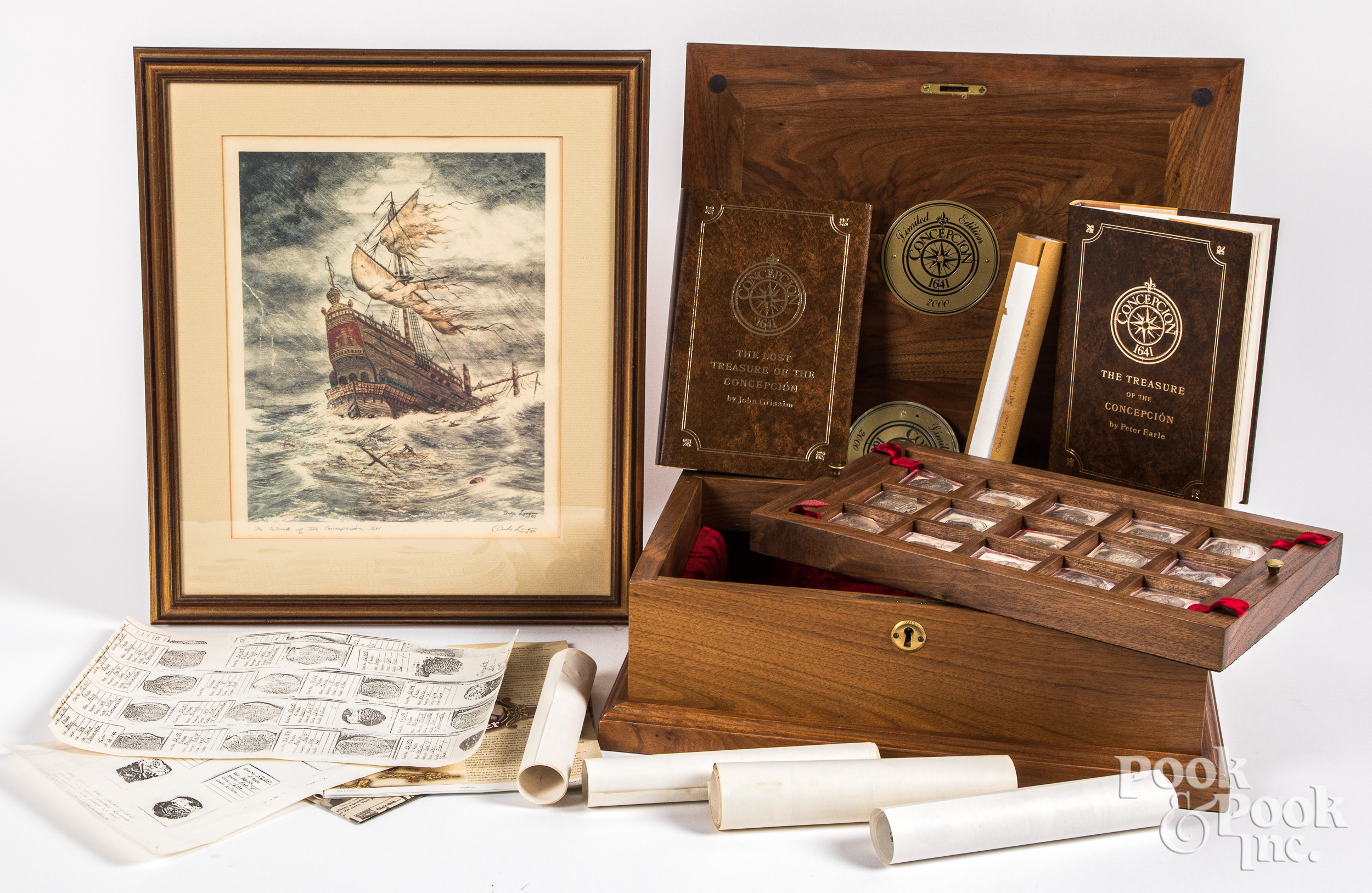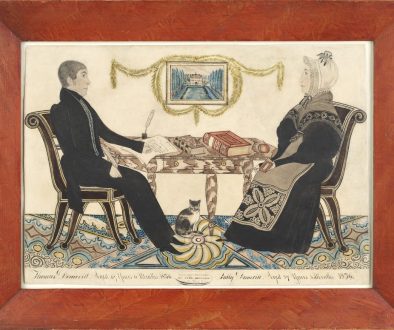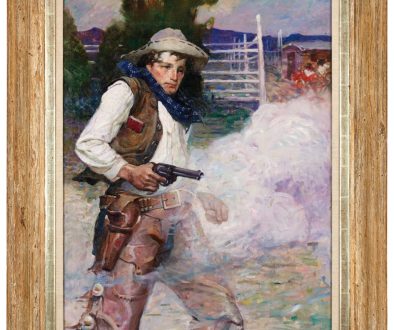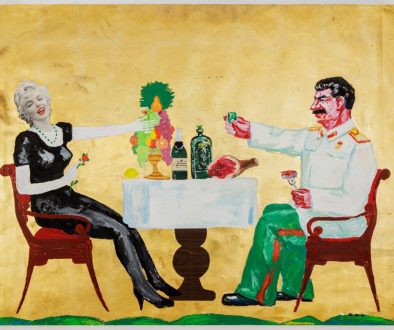Treasure of the Concepción
On a bright day in 1641, under sweltering skies, twenty one ships sailed out of Vera Cruz, the port of New Spain, headed for Seville. They were the ships of the Spanish Treasure Fleet, laden with a fortune in silver, gold, and passengers. A ship shortage the previous year had delayed the fleet’s return trip. For a whole year, the Spanish Crown had been deprived of cash to fund its wars. For a year, the wooden ships of the fleet had been idling in the Vera Cruz harbor. Some of them had not been overhauled for all of that time. Now, overloaded with passengers and cargo, they headed home.
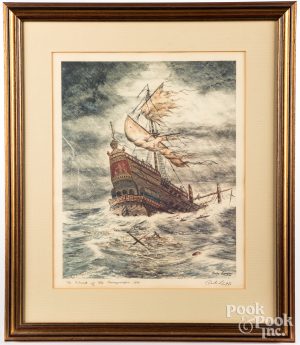
The Concepción, built in Havana in 1620, was a 140 foot long escort galleon, carrying 36 cannon. It also held 496 passengers, with silver cargo and contraband estimated at 140 tons. Plagued by leaks from the outset, the Concepción had to stop for repairs in Havana, forcing a week’s delay for the whole fleet. Setting out again on September 20th, an offshore wind carried the fleet north to the Gulf Stream current, which bore it along the coast of Florida. On the evening of September 28th, the fleet was engulfed in one of the worst hurricanes anyone had ever seen. Concepción’s new repairs and old caulking were washed away. A fifty-foot wave nearly capsized the ship, tipping it far enough that water poured into the gun ports, hatches, and holes, and washed the deck clear of life. After a terrifying night, morning light showed ships scattered and in distress in the intensifying hurricane. Five feet of water in the hold increased to ten, all four bilge pumps and all hands bailing could not drain it. Cannon were jettisoned and the main mast was cut. After two harrowing days, the storm passed, leaving the Concepción alone and becalmed, forced to limp along for several weeks. The crew knew how far north they were, thanks to the astrolabe, but had no idea of their longitude. The opinion of the pilots was that they were far enough east to be north of Puerto Rico. Admiral Don Juan de Villavicenzio vehemently disagreed, believing they were further west, directly above the Abrojos reef, a deadly 40-mile long obstacle. The Admiral was overruled by the pilots, and a shipboard ceremony was conducted in which the angry Admiral washed his hands of responsibility in a silver bowl. The ship turned south in search of Puerto Rico. On October 31, 1641, the Concepción ran aground on the Abrojos reef. Another storm drove it further into the reef, damaging it irreparably. Passengers and crew spent the remaining hours stripping wood from the ship to build rafts (wood being now the most precious commodity on board the treasure ship). In all, the ship’s longboat and rafts carrying 190 passengers were all that survived, mostly by making it to Hispaniola. The remaining 300 souls perished on their rafts. Not one ship of the fleet made it back to Seville.
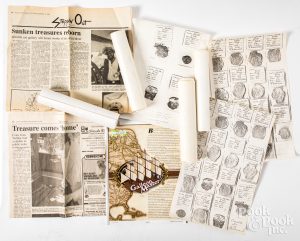
King Philip IV, now seriously short of cash, sent Admiral Villavicenzio on an underfunded salvage mission, but nothing could be found of the Concepción. It was just as well, since his every move was shadowed by corsairs. In a Caribbean full of Dutch, French, and English privateers, pirates, deserters, chancers, and beachcombers, everyone was looking for the treasure. The 1494 Treaty of Tordesillas may have granted Spain sovereignty over all to the west and Portugal the east, but since no other countries signed the treaty, the rush for New World possessions was on. It was not until 45 years later, in what is perhaps colonial America’s first “rags-to-riches” story, that a ship captain from the Massachusetts Bay Colony entered the scene. Thinking big, William Phips petitioned the English king to fund his treasure hunting mission. When the first attempt failed, an undeterred Captain Phips assembled a consortium of financial backers for a second try. In 1687 he struck it rich, finding part of the wreck and returning to England with 32 tons of treasure. Phips became an overnight sensation, a celebrity, and a legend. He was knighted. He was appointed Governor General of Massachusetts. Cotton Mather wrote his biography. When he finally returned to the wreck sight for a second haul, he found the reef stripped bare of anything possible to reach. Coral had begun to encase the wreck. The reef was renamed Silver Shoals and over time its history sank into obscurity.
Nearly 300 years later, Pennsylvanian treasure hunter Burt Webber was on the trail of the Concepción. In 1977, in an expensive and high-tech expedition, he exhaustively surveyed 1,891 coral heads of the Silver Shoals reef and found nothing. Calculating that only a part of the ship could have been found, Webber knew there had to be more. By chance, from a researcher in Seville he learned that British historian Peter Earle had discovered a logbook from the Phips voyage. Hidden for centuries, the book had turned up in the papers of a British Admiral in Maidstone, Kent. The long-lost book provided more detailed information on the location of the wreck. Webber rapidly assembled another expedition. Once again, he searched the reef for weeks. Finally, on November 26, 1978, the Nuestra Señora de la Pura y Limpia Concepción was found.
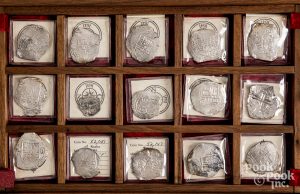
The coins in Lot 1814 in the October 28th Coins & Jewelry Auction at Pook & Pook are from the treasure recovered, and include 8 reales coins (pieces of eight), 4 reales, and 2 reales. The silver was likely mined at Zacatecas and transported by burro train down the Silver Road to Mexico City, where it was struck into coins at the mint. One reale is equivalent to 1/8 ounce. An 8 reales coin could be clipped into eight equal pieces. Interestingly, these coins have another link to colonial America. It is estimated that half the coins in the colonies were Spanish reales. They were the most abundant coins available. In 1645 Virginia made the Spanish real the standard currency. The reale, or peso, was effectively the global currency. At the time the Concepción coins were minted, one third of the New World silver was gathered in the western port of Acapulco. Silver from Potosi was shipped up the coast to either be carried overland by burro train to Vera Cruz, or travel across the pacific in the West Indies Treasure Fleet to Manila in the Spanish Philippines. Even then, China was the world’s largest producer of consumer goods, and with such a large economy, had an insatiable need for silver coinage. Ships would then return to Spain laden with silks and porcelains. The trade boom that followed the voyages of Christopher Columbus, Magellan, and Vasco de Gama established the first truly global trade.
About ten years after Columbus landed on Hispaniola and claimed the New World for Spain, the Spanish Crown set up a House of Trade in Seville to organize the importation, counting, and taxation of New World treasure, taking a “royal fifth” of all incoming. At first treasures arrived that were objects looted from the Aztec Empire by Hernan Cortes, and from the Incan Empire by Francisco Pizarro, as well as from other conquistador efforts on a smaller scale. As the two great empires crumbled under the pressures of warfare and disease, the viceroyalties of New Spain and of Peru took over operation of the gold and silver mines. In 1545 Potosi, an actual mountain of silver, was discovered in the Andes. In 1946, Zacatecas was discovered in the Sierra Madre Occidental. The Spaniards possessed not one, but two mountains of silver and riches on an unimaginable scale. Two annual convoys of up to 100 ships at a time began to bring the treasure to Spain. Between the 16th and the 18th centuries over 150,000 tons of silver, over 80% of the world’s silver supply, was extracted from the Americas. Silver coins fell “like rain on the roof.” Feeling the weight of a Concepción coin in one’s hand, it is difficult to imagine how Spain could have minted so many of these, and yet wound up bankrupt. The answer is economics.
Spain was a victim of its own success in three ways: firstly, the treasure of the Americas made Spain the richest and most powerful country in Europe. Ruled by Habsburg kings, Spain used its riches in Europe conducting wars to defend the west against the Ottoman Empire, to maintain a Catholic hegemony, and in dynastic struggles. Outside of Europe, Spain used its riches to conquer, administer, and defend its colonial possessions. Recalling the Treaty of Tordesillas, Spain had a lot of ground to cover. It was the first modern global power. Overstretched militarily, it also spent more than it earned from the two mountains of silver. Even without the Eighty Years War and the Thirty Years War, the sheer cost of administering and defending the global empire was staggering. In the Caribbean, the threat was constant. Government-sanctioned Dutch, French, and English ships lay in wait for each Treasure Fleet to seize ships, and established colonies and claimed smaller islands on the eastern fringes. This is why the Concepción carried 36 cannon. From 1567 until the 1700’s, Spain also kept the longest-serving standing army in Europe, the Army of Flanders, on payroll to fight its wars on many fronts.
Secondly, with a constant river of unimaginable wealth, Spain lagged behind the Italians and the Dutch in developing a sophisticated banking system. In 1602 the Dutch East India Company established the Bourse in Amsterdam, for trading its stocks and bonds. Financial innovation took the concept of money beyond metal. Money was really about credit, and earnings on assets. American treasure provided the stimulus to innovate. Coinage was no longer rare. It could be spent, or invested and multiplied. Spain remained tied to its metal, using short-term cash advances against the arrival of the Treasure Fleets from merchants in Antwerp. Silver supply shocks, as experienced in 1640-41, when there were not enough ships for the 1640 Treasure Fleet, and the 1641 fleet sank, had severe effects, resulting in Spain defaulting on its debt in 1557, 1560, 1575, 1596, 1607, 1627, 1647, 1652 and 1662.
But the third, and main, reason Spain was to lose its wealth, power, and empire was inflation. The value of silver reales was not absolute. European money was mainly silver coinage. Spain added 150,000 tons of silver to Europe, increasing the supply of silver by nearly 400%. Spain spent these reales faster than they came in, the coins passing through their hands to pay banks, armies, and suppliers all over Europe. Spain’s wealth caused price levels to rise 6 or 7 times their previous levels. This 150 year period is known as the European Price Revolution. The quantity theory of money is the standard explanation for this price rise. Simply put, it states that too much money chasing too few goods, all other things being equal, will cause prices to rise. In terms of purchasing power, one reale could buy less and less corn. In the hard money world of the time, the addition of 150,000 tons of silver was a significant event. The result was inflation. For a sixty year period from 1580-1640, American mines produced about the same amount of silver. But by 1640, the amount of silver was worth only a fraction of what it had been in 1580. Due to the decreasing value of the Treasure Fleets, their arrival could no longer pay all of the bankers, armies, and suppliers Spain needed to maintain its empire. Price rises only stopped around 1650 when the price of silver coinage in Europe fell to such a low level that it was no longer profitable to import it from the Americas.
The legacy of Spain’s mountains of silver, of these coins of the Concepción, was modern finance. The price revolution by itself did not cause the birth of capitalism, but it provided the entrepreneurial stimulus.
The Concepción coins are relevant to history in so many ways, from the romance of sunken treasure, the search for gold, American rags-to-riches, the discovery of the New World and the path between the seas, shipwreck and piracy; to warfare and the demise of the Aztec, Incan, and Spanish empires; to global trade, capitalism, and modern finance. Suddenly, the Concepción coin in one’s hand feels infinitely heavy, with the weight of history.
By: Cynthia Beech Lawrence
*****
Sources:
Fisher, Douglas, ‘The Price Revolution: A Monetary Interpretation’. The Journal of Economic History, Vol. 49, No. 4, Dec. 1989, Cambridge University Press.
Hamilton, Earl J., ‘American Treasure and the Price Revolution in Spain, 1501-1650,’ Cambridge, MA, 1934.
Earle, Peter, ‘The Treasure of the Concepción,’ Viking Press, NY, 1980.
Ferguson, Niall, ‘The Ascent of Money,’ Penguin Books, 2008.

